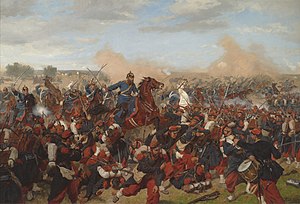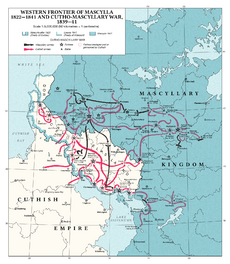Second Cutho-Mascyllary War: Difference between revisions
No edit summary |
The ©rusader (talk | contribs) mNo edit summary |
||
| (2 intermediate revisions by one other user not shown) | |||
| Line 30: | Line 30: | ||
* {{flagicon image|MascyllaFlagIII.png}} '''[[Monarchy of Mascylla|Lukas II]]''' | * {{flagicon image|MascyllaFlagIII.png}} '''[[Monarchy of Mascylla|Lukas II]]''' | ||
* {{flagicon image|MascyllaFlagIII.png}} [[Prime Minister of Mascylla|Friedrich von Gäste]] | * {{flagicon image|MascyllaFlagIII.png}} [[Prime Minister of Mascylla|Friedrich von Gäste]] | ||
* {{flagicon image|MascyllaFlagIII.png}} Prince | * {{flagicon image|MascyllaFlagIII.png}} Prince Wilhelm | ||
* {{flagicon image|MascyllaFlagIII.png}} Christoph von Neitzel | * {{flagicon image|MascyllaFlagIII.png}} Christoph von Neitzel | ||
* {{flagicon image|MascyllaFlagIII.png}} | * {{flagicon image|MascyllaFlagIII.png}} Albrecht von Beenke | ||
* {{flagicon image|MascyllaFlagIII.png}} Crown Prince | * {{flagicon image|MascyllaFlagIII.png}} Crown Prince Lothar | ||
* {{flagicon image|MascyllaFlagIII.png}} '''[[Prime Minister of Mascylla|Emmanuel Lyder]]''' | * {{flagicon image|MascyllaFlagIII.png}} '''[[Prime Minister of Mascylla|Emmanuel Lyder]]''' | ||
* {{flagicon image|MascyllaFlagIII.png}} Walther von Schönherr | * {{flagicon image|MascyllaFlagIII.png}} Walther von Schönherr | ||
| Line 66: | Line 66: | ||
==Aftermath== | ==Aftermath== | ||
[[Category: | [[Category:Mascylla]][[Category:Cuthland-Waldrich]][[Category:History of Mascylla]][[Category:History of Cuthland-Waldrich]] | ||
Latest revision as of 09:00, 21 September 2021
This article is incomplete because it is pending further input from participants, or it is a work-in-progress by one author. Please comment on this article's talk page to share your input, comments and questions. Note: To contribute to this article, you may need to seek help from the author(s) of this page. |
| Second Cutho-Mascyllary War | |||||||||
|---|---|---|---|---|---|---|---|---|---|
| Part of the Ahlstead Wars | |||||||||
 The Battle of Wittsee, 16 May 1840 | |||||||||
| |||||||||
| Belligerents | |||||||||
|
|
| ||||||||
| Commanders and leaders | |||||||||
|
| ||||||||
| Strength | |||||||||
| X | 646,100 | ||||||||
| Casualties and losses | |||||||||
|
X
|
305,960
| ||||||||
| Events leading to the Great War | ||||||||||||||||||||||||
|---|---|---|---|---|---|---|---|---|---|---|---|---|---|---|---|---|---|---|---|---|---|---|---|---|
 | ||||||||||||||||||||||||
|
||||||||||||||||||||||||
The Second Cutho-Mascyllary War, otherwise known as the Elpsland War, Third Ahlstead War and War of 1840, was a military conflict between the Second Cuthish Empire and the Mascyllary Kingdom lasting from 8 September 1839 to 2 January 1841. The conflict was brought about by Cuthland's political and military ambitions to regain its former dominant position in Berea which it had lost as the First Cuthish Empire with the Partitions of Cuthland and emergence of Mascylla as a unified nation state after the War of the Five Kings in 1793. Cuthish monarch Edwin III was determined to regain its former peak territorial extent and reassert revanchist goals for Cuthland, prompting the Ahlstead Wars. After the successful Second Cutho-Waldish War of 1832 and X Peninsula War of 1834, civil popularity for his ambitions emboldened Edwin III to declare war on Mascylla on 8 September 1839.
Cuthland mobilized immediately prior to the war declaration, and made efficient use of railways and the telegraph as means of communication to cross the border at Mohlnau on September 10. Mascyllary troops were inferior in their garrisoned numbers, technological assets and tactical decisionmaking, and unaware of Cuthish troop movements. The Reichsrat ordered mobilization the day after the Battle of Mohlnau on September 11, mainly due to the initial delay in messages and attempted diplomatic communication which were refused by the Cuthish. While Mascylla had a larger standing army and home advantage, the Cuthish military were superior and overwhelmed the Mascyllary army in their first major victory in the Battle of Klein-Tolbern on September 14.
The Cuthish retained their artillery and mobility advantage throughout the war, scoring a series of significant victories, most notably in the Battle of Vogtburg on October 19, 1839, and the Siege of Augusthal from November 10, 1839, to April 3, 1840. The decisive defeat of the bulk of the Mascyllary army at Vogtburg unsettled Lukas II, who had hoped for a major turn in events. The demoralized and rapidly collapsing Mascyllary military retreated northward while the Cuthish exploited the gap in defences to besiege Königsreh beginning on June 1, 1840, while other attempts at breaking and dispersng Mascyllary defences were made with the Battle of Wittsee at 16 May 1840 and the Battle of Grünhagen at 15 December 1839. The hastily organized counter defences were however able to bloodily force the besieging army to disperse and capitulate after a crop failure and increasing unrest in the Cuthish armies due to a smallpox epidemic, but to no avail as Königsreh was forced to capitulate in summer and a provisional government, the National Government of Accord and Defence (Nationalregierung für Einigkeit und Verteidigung) led by Emmanuel Lyder, willing to sign a treaty of surrender at Marienfelde on 1 November 1840.
The Treaty of Alderport, signed on 2 January 1841, forced Mascylla to cede Dorsace, Mogdland and Elpsland to Cuthland, essentially restoring the borders of the First Cuthish Empire in 1776 in Mascylla, as well as colonial possessions in Alvinia and Caphtora and pay war reparations of some four billion karnings. The shift in power with a regrowing Cuthish Empire and weakened Mascylla greatly upset Berean politics, and constituted the Cuthish–Mascyllary enmity as a major geopolitical, demographic and economic rivalry. Mascyllary revanchist determination to regain its lost territories and restore its pride, the fear of another Cutho-Mascyllary War and Lavish apprehension of a growing Cuthish-Dulebian alliance in the 1880s became pivotal causes for the Great War.
